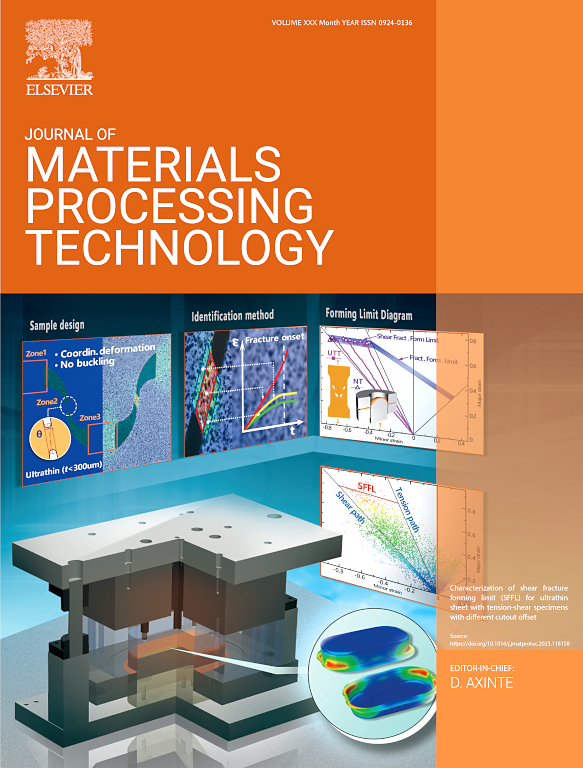半导体硅片切割上部裂缝形成机制的理论与实验研究:基于叶片结构的裂缝区域建模
IF 7.5
2区 材料科学
Q1 ENGINEERING, INDUSTRIAL
Journal of Materials Processing Technology
Pub Date : 2025-06-16
DOI:10.1016/j.jmatprotec.2025.118937
引用次数: 0
摘要
机械切割是硅片加工的最后一步,直接决定了芯片的质量。在此过程中很容易发生上部裂缝,增加了芯片失效的风险。然而,目前对上部裂缝的形成机理和控制方法还没有专门的研究。为了解决这一挑战,本研究探讨了硅片切割过程中上部裂缝的形成机制。根据去除材料的不同,切丁刀片分为两个磨削区:主要磨削区(PGZ)位于刀片外周,进行切入磨削,次要磨削区(SGZ)位于刀片侧面,进行面磨。根据上部裂缝间的相互作用,将上部裂缝划分为三种类型:初级磨砂区、次级磨砂区和混合裂缝。详细讨论了这些裂缝类型的形成过程。将三种断裂形成机制与裂纹扩展条件相结合,建立了考虑叶片特性的上层断裂区域模型,解决了脆性材料切割过程中断裂研究的理论空白。随后进行了一系列的硅切参数实验,准确识别出三种断裂类型。结果表明,二次磨削区断口比例与平均断口面积成反比。因此,通过参考该模型,控制加工参数,可以降低二次磨削区断裂比例,从而控制断裂面积。此外,与不考虑裂缝类型的模型相比,本文建立的考虑不同裂缝类型的分段模型将裂缝面积计算的平均错误率从19.5 %降低到12.51 %。本研究为减少硅切片断裂面积,提高切片质量提供了有价值的见解,可为其他硬脆材料切片断裂研究提供参考。本文章由计算机程序翻译,如有差异,请以英文原文为准。
Theoretical and experimental investigation on topside fracture formation mechanisms in semiconductor silicon dicing: Modeling of fracture area based on blade structure
Mechanical dicing is the final step in silicon wafer processing and directly determines the quality of the chips. Topside fracture readily occurs during this process, increasing the risk of chip failure. However, there is currently no research on the mechanism of topside fracture formation and control methods specifically for dicing. To address this challenge, this study investigates the formation mechanism of topside fracture during silicon wafer dicing. The dicing blade is divided into two grinding zones based on material removal: the primary grinding zone (PGZ) on the outer circumference, which performs plunge grinding, and the secondary grinding zone (SGZ) on the side of the blade, which performs face griding. Topside fracture is classified into three types—the primary grinding zone, the secondary grinding zone, and mixed fracture—based on the interaction between these zones. The formation processes of these fracture types are discussed in detail. A topside fracture area model, which accounts for blade characteristics, was developed by integrating the three fracture formation mechanisms with crack propagation conditions, addressing the theoretical gap in the study of fracture during the dicing of brittle materials. Subsequently, a series of silicon dicing parameter experiments were conducted, accurately identifying the three types of fracture. It was found that the proportion of secondary grinding zone fracture was inversely proportional to the average fracture area. Therefore, by referring to the model and controlling the processing parameters, it is possible to reduce the proportion of secondary grinding zone fracture and, in turn, control the fracture area. Additionally, the segmented model established in this study, which takes different types of fracture into consideration, reduced the average error rate of fracture area calculations from 19.5 % to 12.51 %, compared to a model that does not account for fracture types. This research provides valuable insights into reducing silicon dicing fracture areas and improving dicing quality, serving as a reference for the study of fracture in the dicing of other hard-brittle materials.
求助全文
通过发布文献求助,成功后即可免费获取论文全文。
去求助
来源期刊

Journal of Materials Processing Technology
工程技术-材料科学:综合
CiteScore
12.60
自引率
4.80%
发文量
403
审稿时长
29 days
期刊介绍:
The Journal of Materials Processing Technology covers the processing techniques used in manufacturing components from metals and other materials. The journal aims to publish full research papers of original, significant and rigorous work and so to contribute to increased production efficiency and improved component performance.
Areas of interest to the journal include:
• Casting, forming and machining
• Additive processing and joining technologies
• The evolution of material properties under the specific conditions met in manufacturing processes
• Surface engineering when it relates specifically to a manufacturing process
• Design and behavior of equipment and tools.
 求助内容:
求助内容: 应助结果提醒方式:
应助结果提醒方式:


